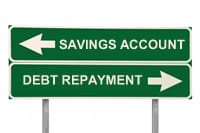In our last Quick Tips, we talked about refinancing your mortgage. I hope you did your homework. If you decided that refinancing is right for you, you may be tempted to pay off your other debts by financing them into your mortgage.
Should you do it? Follow these steps to find out.
List all your debts
If debt is a problem for you, take a closer look. Make 5 columns:
Column 1: Write down the name of each creditor (credit card companies, auto dealership, bank, hospital, etc.)
Column 2: Write down why you took a loan or used a credit card. This will help you see how you came to be in debt. Were these essential expenses like a car or a hospital emergency? Or, were these items you could have saved for, like a vacation, clothes, or furniture.
Column 3. Write down the interest rate.
Column 4. Write down the current payment amount.
Column 5. Write down when it will be paid off at the current payment rate.
I know that this can be scary, but you need to know. Congratulate yourself for doing this. This is a huge step forward.
Why is it important to really look at your debt? If your debts just disappear into your mortgage, you could forget where they came from. Most people who consolidate their debt this way have credit card debt again in just a few years. My assistant told me that it happened to her, and she regrets it. Not only was her mortgage increased, but it delayed the real cure: fixing the leaks in her budget.
Refinancing may not be the answer, but knowing how and why you spend will help you stay out of debt in the long run.
Consider the downside of consolidating credit card debt into your mortgage
Credit card debt is unsecured, so you would be taking unsecured debt and betting your house on it (securitizing it).
When you have credit card debt and can’t make payments, that’s a problem – but, your creditors cannot take your home. On the other hand, if you can’t make your mortgage payments, then you could lose your home in foreclosure. If you increased your mortgage loan in order to cover credit card debt, you could end up with a larger house payment – one that you can’t afford! That’s why I don’t recommend refinancing your unsecured debt into a mortgage.
Consider the long term outcome when refinancing secured debts into your mortgage
Secured debt has a physical object that can be repossessed if you don’t pay: it could be a car, or even a home equity loan or line of credit. Here are three questions you should ask before making your decision:
1. If you combine your mortgage with your home equity will this mean you need to pay mortgage insurance? Mortgage insurance is added when the total amount of your mortgage is equal to, or over, 80% of your home’s appraised value. That will increase your monthly mortgage payment.
2. Will you need the home equity line in the future? It will be difficult to get a new line in these economic times.
3. Is it better to pay off your debts yourself, and have a tight budget for the short term? Or combine them with your refinance and have a bigger mortgage in the long term?
Think long and hard about what you put into your new mortgage. Consult with your tax preparer for an objective opinion.




